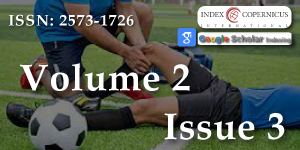Characterisation of Delayed Onset of Muscle Soreness (DOMS) in the hand, wrist and forearm using a finger dynamometer: A pilot study
Main Article Content
Abstract
Background: Experimentally-induced delayed-onset muscle soreness of large muscle groups is frequently used in as an injurious model of muscle pain. We wanted to develop an experimental model of DOMS to to mimic overuse injuries from sports where repeated finger flexion activity is vital such as rock climbing. The aim of this pilot study was to evaluate the utility of a ‘finger trigger device’ to induce DOMS in the fingers, hands, wrists and lower arms.
Methods: A convenient sample of six participants completed an experiment in which they undertook finger exercises to exhaustion after which measurements of pain, skin sensitivity to fine touch, forearm circumference and grip strength in the hand, wrist and forearm were taken from the experimental and contralateral non-exercised (control) arms.
Results: Pain intensity was greater in the experimental arm at rest and on movement when compared with the control arm up to 24 hours after exercise, although the location of pain varied between participants. Pressure pain threshold was significantly lower in the experimental arm compared with the control arm immediately after exercises locations close to the medial epicondyle but not at other locations. There were no statistical significant differences between affected and non-affected limbs for mechanical detection threshold, forearm circumference or grip strength.
Conclusion: Repetitive finger flexion exercises of the index finger by pulling a trigger against a resistance can induced DOMS. We are currently undertaking a more detailed characterization of sensory and motor changes following repetitive finger flexion activity using a larger sample.
Article Details
Copyright (c) 2017 Jones G, et al.

This work is licensed under a Creative Commons Attribution-NonCommercial 4.0 International License.
Dannecker EA, Koltyn KF. Pain during and within hours after exercise in healthy adults. Sports Med. 2014; 44: 921-942. Ref.: https://goo.gl/eKgZnA
Lewis PB, Ruby D, Bush-Joseph CA. Muscle soreness and delayed-onset muscle soreness. Clin Sports Med. 2012; 31: 255-262. Ref.: https://goo.gl/4Mqspv
Mizumura K, Taguchi T. Delayed onset muscle soreness: Involvement of neurotrophic factors. J Physiol Sci. 2016; 66: 43-52. Ref.: https://goo.gl/rMW2Si
Olesen AE, Andresen T, Staahl C, Drewes AM. Human experimental pain models for assessing the therapeutic efficacy of analgesic drugs. Pharmacol Rev. 2012; 64: 722-779. Ref.: https://goo.gl/BH6XYo
Staahl C, Drewes AM. Experimental human pain models: a review of standardised methods for preclinical testing of analgesics. Basic Clin Pharmacol Toxicol. 2004; 95: 97-111. Ref.: https://goo.gl/2vYkPY
Jones G, Asghar A, Llewellyn DJ. The epidemiology of rock-climbing injuries. Br J Sports Med. 2008; 42: 773-778. Ref.: https://goo.gl/amFyko
Jones G, Johnson MI. A Critical Review of the Incidence and Risk Factors for Finger Injuries in Rock Climbing. Curr Sports Med Rep. 2016; 15: 400-409. Ref.: https://goo.gl/uvQkXa
Jones G, Llewellyn D, Johnson MI. Previous injury as a risk factor for reinjury in rock climbing: a secondary analysis of data from a retrospective cross-sectional cohort survey of active rock climbers. BMJ Open Sport Exerc Med. 2015; 1. Ref.: https://goo.gl/oBA1ja
Delfa de la Morena JM, Samani A, Fernandez-Carnero J, Hansen EA, Madeleine P. Pressure pain mapping of the wrist extensors after repeated eccentric exercise at high intensity. J Strength Cond Res. 2013; 27: 3045-3052. Ref.: https://goo.gl/NV7G47
Madeleine P, Hansen EA, Samani A. Linear and nonlinear analyses of multi-channel mechanomyographic recordings reveal heterogeneous activation of wrist extensors in presence of delayed onset muscle soreness. Med Eng Phys. 2014; 36: 1656-1664. Ref.: https://goo.gl/BEp39s
Kinser AM, Sands WA, Stone MH. Reliability and validity of a pressure algometer. J Strength Cond Res. 2009; 23: 312-314. Ref.: https://goo.gl/S1Mwnv
Bove G. Mechanical sensory threshold testing using nylon monofilaments: The pain field’s “Tin Standard”. Pain. 2009; 124: 13-17. Ref.: https://goo.gl/unL6Zc
Bohannon RW, Schaubert KL. Test-retest reliability of grip-strength measures obtained over a 12-week interval from community-dwelling elders. J Hand Ther. 2005; 18: 426-427. Ref.: https://goo.gl/V9PJmL
Black CD, Tynes BK, Gonglach AR, Waddell DE. Local and Generalized Endogenous Pain Modulation in Healthy Men: Effects of Exercise and Exercise-Induced Muscle Damage. Pain Med. 2016; 17: 2422-2433. Ref.: https://goo.gl/2gGKTF
Uddin Z, MacDermid JC. Quantitative Sensory Testing in Chronic Musculoskeletal Pain. Pain Med. 2016; 17. 1694-1703. Ref.: https://goo.gl/7bc4Nh
Khamwong P, Paungmali A, Pirunsan U, Joseph L. Prophylactic Effects of Sauna on Delayed-Onset Muscle Soreness of the Wrist Extensors. Asian J Sports Med. 2015; 6. Ref.: https://goo.gl/mQZhzm

